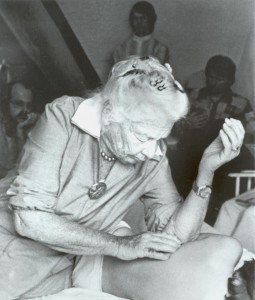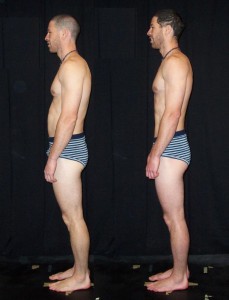
Rolfing Structural Integration pays homage to its founder, Dr. Ida P. Rolf. This brilliant and charismatic innovator was a biochemist who studied the properties of myofascia at Columbia University (before most women were even accepted as colleagues in the world of science). She was interested in a great multitude and variety of topics germane to the human experience but developed a reputation for healing people through movement. Eventually, she paired movement with manual intervention, uniquely attuned to affect the material of fascia. Using fascia as the working material for her intention, Dr. Rolf evolved a unique system of progressive interventions that transformed the bodies of her clients over a brief period of time into organized systems, excavated from the habits, traumas, and daily influences that imprinted them. Dr. Rolf wanted to call her system Structural Integration; her students wanted to call it Rolfing.
Though it can be intense, Rolfing is simply not “that kind” of painful anymore. Most people find a Rolf session less painful than the pain they already experience, and chances are good that Rolfing will help alleviate that everyday pain. Most People also find Rolfing less painful than a typical deep tissue massage.
I promise to negotiate any of the session’s intensity with you. Partnering with you to keep communication honest and clear, I can slow my interventions, decrease pressure, change angles, or otherwise modify my techniques to ensure that you can integrate them, getting the very most from your session. If you have experienced intensity in a workout, yoga, or massage, you can probably handle Rolfing Structural Integration with me.

Rolfing helps bring bodies to a higher level of order by aligning their structural elements to the flow of gravity. Because we are designed for upright functioning, this supports the body in what it’s already trying to accomplish.
Aligning and rebalancing the body requires a systematic approach to working with a person’s tissue; practically no stone is left unturned. The actual hands-on work feels good and provides an inherent health benefit to the client, but the process of Rolfing does more than just this.
When a body is properly harmonized with gravity, it no longer requires extra tension to hold itself up. The complicated set of reflexes responsible for our unconscious uprightness require less math, and therefore less energy to do so. Rolfing also helps dismantle separate and contrasting patterns that cause pain and dysfunction when they clash, so the body is no longer fighting itself. All said and done, a Ten Series allows the body to heal and support itself on its own terms, allowing the body to heal itself!
I will instruct you in taking specific positions on a standard massage table, in standing, or sitting on a bench or stool during the course of the work. Manual therapy always accompanies positional strategies. I will work with you using my hands, but I will also ask for your attention to the process, and I will ask for small or large movements during the work.
The ability to better connect to oneself and one’s inherent unity, also to transform our most constant obstacle into a possible gift, has profound and powerful emotional, belief, and behavioral implications for many people. Rolfing doesn’t do this; people do this for themselves by experiencing themselves in a different way. Rolfing rather helps reorder the person into greater integration, using gravity as a guide and aide, and the rest is up to them. This helps people to stand, walk, sit, squat, and even run with greater ease. Practicing “good” posture and form becomes less difficult.
Massage fails to translate both the effects and the experience of Structural Integration. While massage is a fantastically effective way of restoring the body from a condition of stress or strain to one of a more familiar ease, it doesn’t necessarily elevate a person’s level of order. Rolfing Structural Integration is a great adjunct to any transformative endeavor, and can significantly reduce stress and strain as a result.
Rolfing doesn’t feel the same way, nor do they approach the concept of depth in the same way as massage therapy. Though Rolfers can and do use depth to great effect, we don’t go digging for knots. Our interventions don’t use kneading or gliding either. Rather Rolfers tend to meet the most available layer of their client’s body, and use their intention to work from there into deeper layers and sometimes distant areas. This helps us free and spread tissue into areas of need, allowing for greater support or adaptability in those areas. It also allows Rolfers to go deep without using too much strength, which can be painful to both practitioner and receiver. Use of movement cues and positional strategies similarly separate Rolfing from a typical massage.
All this being said many techniques and positional strategies from the Rolfing Structural Integration repertoire have emerged in the world of deep tissue and therapeutic massage, largely thanks to Rolfers who wish to share their knowledge with the world (generous souls such as Tom Myers, Til Luchau, Art Riggs, Erik Dalton, and even Peter Levine come to mind). You very well may have already felt some of this work in the form of myofascial release, active release, pin and stretch techniques, in side lying positions, or with similarly advanced interventions. Yet even the most advanced massage is not really Rolfing Integration, because those massage sessions seek to address local areas of disfunction, rather than to increase the body’s order.
Rolfing Structural Integration Ten Series is a progressive and systematic series of manual interventions. Each session contains specific goals and address specific territories to be integrated together. Each session builds on the last and prepares for the next, completing the work that came before and beginning a new phase simultaneously. All of this reflects Dr. Rolf’s concepts as they follow a human body aligning within gravity.
Massage grew out a need to rub what hurts, and evolved into a spectacular array of interventions. There will always be a need for massage. It is not Rolfing Structural Integration and will not be replaced by Rolfing, nor will Rolfing replace massage. Rolfing SI grew from a need to align people with the flow of gravity, and to themselves in an integrated body. Form here they can may be able to heal themselves.
Structure works with gravity, forming channels, damns, and platforms. Like the proverbial river that shapes the hard mountain rock, gravity forms our body, shaping us according to how we stand and move. Better alignment with gravity equates to better posture and movement. Better posture and movement equates to better health, energy, and well being.
Dr. Rolf was known to say that the real work happened after the 10 series had finished. A body that has progressed through the ten exhibits better functionality, and better relationship between the pieces/parts to the whole. Yet it is after this milestone that the client’s nervous system may attenuate to its new reality. It is after this milestone that we experience a reality separate from the beliefs and events that brought us to our pre-ordered self. If we work with this, then it will be after the 10 series that we change our consciousness.
These progressive and systematic sessions of manual intervention contain specific goals, cover specific territory, and address specific purposes. The hours describe structural relationships to reestablish, movement functionality to restore, and an order in which to proceed.
The first 3 sessions address the superficial fascia in a stepwise manner to improve adaptability, support, and front/back balance. We consider these “sleeve” sessions. The following 4 through 7 sessions follow the core of your body from your plantar fascia up through the deeper structures of head and neck. We consider those as core sessions. Sessions 8, 9, and 10 focus on integrating the work more deliberately by establishing movement and interaction from the core through the sleeve, and into the world. One session sets up the next two sessions. Those sessions complete the work that came before, and begin a new phase simultaneously. In essence the 10 series could be considered one large 10 hour treatment.
Once you have assimilated and manifested the changes of a 10 session series, we can begin post-ten work. Post 10 work can help with recent injuries, or can address issues that inhibit a deepening in the assimilation/manifestation process. Post-ten work also moves into new territory. If the 10 returns us to our birthright, the natural heritage of un-cultured movement, then the post 10 work helps us to evolve further.